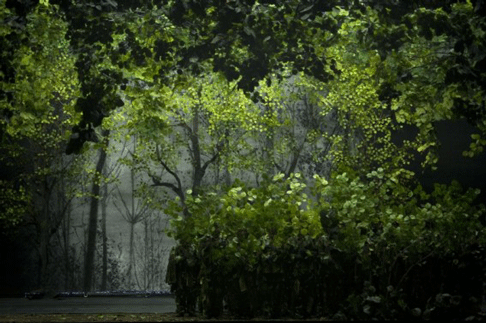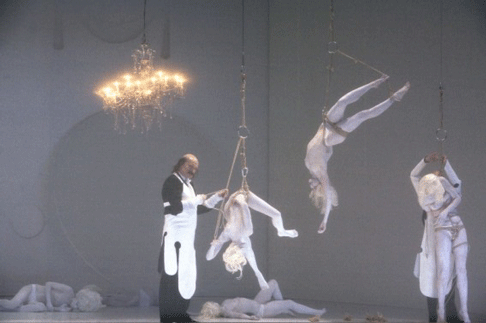![Anna Larsson as Kundry [Photo by Bernd Uhlig courtesy of La Monnaie | De Munt]](http://www.operatoday.com/9_Parsifal_26press.gif)
12 Feb 2011
Parsifal in Brussels
Romeo Castellucci is the cat’s whisker of current avant-garde theater directors. Thus it has simply been a matter of time before he would be invited to the Monnaie to stage an opera.
English Touring Opera are delighted to announce a season of lyric monodramas to tour nationally from October to December. The season features music for solo singer and piano by Argento, Britten, Tippett and Shostakovich with a bold and inventive approach to making opera during social distancing.
This tenth of ten Live from London concerts was in fact a recorded live performance from California. It was no less enjoyable for that, and it was also uplifting to learn that this wasn’t in fact the ‘last’ LfL event that we will be able to enjoy, courtesy of VOCES8 and their fellow vocal ensembles (more below …).
Ever since Wigmore Hall announced their superb series of autumn concerts, all streamed live and available free of charge, I’d been looking forward to this song recital by Ian Bostridge and Imogen Cooper.
The Sixteen continues its exploration of Henry Purcell’s Welcome Songs for Charles II. As with Robert King’s pioneering Purcell series begun over thirty years ago for Hyperion, Harry Christophers is recording two Welcome Songs per disc.
Although Stile Antico’s programme article for their Live from London recital introduced their selection from the many treasures of the English Renaissance in the context of the theological debates and upheavals of the Tudor and Elizabethan years, their performance was more evocative of private chamber music than of public liturgy.
In February this year, Albanian soprano Ermonela Jaho made a highly lauded debut recital at Wigmore Hall - a concert which both celebrated Opera Rara’s 50th anniversary and honoured the career of the Italian soprano Rosina Storchio (1872-1945), the star of verismo who created the title roles in Leoncavallo’s La bohème and Zazà, Mascagni’s Lodoletta and Puccini’s Madama Butterfly.
Evidently, face masks don’t stifle appreciative “Bravo!”s. And, reducing audience numbers doesn’t lower the volume of such acclamations. For, the audience at Wigmore Hall gave soprano Elizabeth Llewellyn and pianist Simon Lepper a greatly deserved warm reception and hearty response following this lunchtime recital of late-Romantic song.
Collapsology. Or, perhaps we should use the French word ‘Collapsologie’ because this is a transdisciplinary idea pretty much advocated by a series of French theorists - and apparently, mostly French theorists. It in essence focuses on the imminent collapse of modern society and all its layers - a series of escalating crises on a global scale: environmental, economic, geopolitical, governmental; the list is extensive.
For this week’s Live from London vocal recital we moved from the home of VOCES8, St Anne and St Agnes in the City of London, to Kings Place, where The Sixteen - who have been associate artists at the venue for some time - presented a programme of music and words bound together by the theme of ‘reflection’.
'Such is your divine Disposation that both you excellently understand, and royally entertaine the Exercise of Musicke.’
Amongst an avalanche of new Mahler recordings appearing at the moment (Das Lied von der Erde seems to be the most favoured, with three) this 1991 Mahler Second from the 2nd Kassel MahlerFest is one of the more interesting releases.
‘And there was war in heaven: Michael and his angels fought against the dragon; and the dragon fought and his angels, And prevailed not; neither was their place found any more in heaven … that old serpent … Satan, which deceiveth the whole world: he was cast out into the earth, and his angels were cast out with him.’
If there is one myth, it seems believed by some people today, that probably needs shattering it is that post-war recordings or performances of Wagner operas were always of exceptional quality. This 1949 Hamburg Tristan und Isolde is one of those recordings - though quite who is to blame for its many problems takes quite some unearthing.
There was never any doubt that the fifth of the twelve Met Stars Live in Concert broadcasts was going to be a palpably intense and vivid event, as well as a musically stunning and theatrically enervating experience.
‘Love’ was the theme for this Live from London performance by Apollo5. Given the complexity and diversity of that human emotion, and Apollo5’s reputation for versatility and diverse repertoire, ranging from Renaissance choral music to jazz, from contemporary classical works to popular song, it was no surprise that their programme spanned 500 years and several musical styles.
The Academy of St Martin in the Fields have titled their autumn series of eight concerts - which are taking place at 5pm and 7.30pm on two Saturdays each month at their home venue in Trafalgar Square, and being filmed for streaming the following Thursday - ‘re:connect’.
The London Symphony Orchestra opened their Autumn 2020 season with a homage to Oliver Knussen, who died at the age of 66 in July 2018. The programme traced a national musical lineage through the twentieth century, from Britten to Knussen, on to Mark-Anthony Turnage, and entwining the LSO and Rattle too.
With the Live from London digital vocal festival entering the second half of the series, the festival’s host, VOCES8, returned to their home at St Annes and St Agnes in the City of London to present a sequence of ‘Choral Dances’ - vocal music inspired by dance, embracing diverse genres from the Renaissance madrigal to swing jazz.
Just a few unison string wriggles from the opening of Mozart’s overture to Le nozze di Figaro are enough to make any opera-lover perch on the edge of their seat, in excited anticipation of the drama in music to come, so there could be no other curtain-raiser for this Gala Concert at the Royal Opera House, the latest instalment from ‘their House’ to ‘our houses’.
"Before the ending of the day, creator of all things, we pray that, with your accustomed mercy, you may watch over us."
![Anna Larsson as Kundry [Photo by Bernd Uhlig courtesy of La Monnaie | De Munt]](http://www.operatoday.com/9_Parsifal_26press.gif)
Romeo Castellucci is the cat’s whisker of current avant-garde theater directors. Thus it has simply been a matter of time before he would be invited to the Monnaie to stage an opera.
Unlike most avant-garde artists Sig. Castellucci has earned mainstream credibility and recognition (France’s major daily newspaper Le Monde named his Divine Comedy cycle the best theatrical event dans le monde for the first decade of the twenty-first century!).
Here in the south of France Sig. Castellucci created one of his eleven-piece cycle La Tragedia Endogonidia for Marseille (each part was created in different cities). We were led, blind, into a black space and left standing, lights illuminated a huge pile of furniture, a brutal action occurred, meanwhile the mess of furniture disappeared and a survivor of the action sat at a piano and played the Gymnopédie #3 (the one everyone knows). Twenty minutes after we had entered the space we left.
In Brussels it was into the splendor of the Théâtre Royal de la Monnaie that we entered and some four hours plus later we emerged. What had happened was that a kinetic mess of a forest (trees kept falling) gave way to a brutal action and the survivor then marched to the Holy Grail. And, uhm, that is more or less what happens in Dante’s Divine Comedy too.
While Sig. Castellucci may be stuck in his story telling he is not stuck in the imagery, and that is of course what his art is all about. The Parsifal at the Monnaie was not about Wagner’s Parsifal but about Sig. Castellucci’s art. And that art is considerable and there is no shortage of self congratulation. To wit, Klingsor is a chef d’orchestre, the holy lance is his baton but Parsifal does not catch it because Klingsor lays it on the floor and walks off the stage. Thus in this improvised second act contest between stage and pit Mr. Castellucci seems to be the winner.
Not to mention that for the entire overture a huge image of Nietsche was projected above the orchestra. FYI Nietsche detested Wagner.
Sig. Castellucci’s imagistic language is rife with reference, and like most music the images are not metaphors of ideas or translated spaces but superimpositions of impressions. When examined these vast impressions lead to so many conceptual conclusions that no one may be identified as the absolute. Though it is fun to try.
The first unveiling of the Holy Grail is a clue to Sig. Castellucci’s artistic intuition. A huge white sheet suddenly covered the kinetic forest, thus all motion stopped as we were confronted only with one small, black quotation mark in this void of white — the word of God? As the final vision of the Grail was unfolding Parsifal and the multitudes marched relentlessly forward it (a rolling stage floor allowed the perpetual forward marching). The lights in auditorium were illuminated — we knew that we are not only a part of the multitudes, we were the Grail itself. Well, why not refer this magnificent affirmation of existence to Satie’s insipid ditty.

Too bad for Sig. Castellucci, but the pit won after all. Wagner’s magnetic score received a magnificent reading at the baton of German conductor Hartmut Haenchen who was clearly sympathetic to this reduction of Wagner’s holy rite to visual images — his task was now purely musical rather than dramatic. Never before have such sounds emerged from a pit, the antagonistic guttural attacks of the string bows, shattering fortes, earth shaking fortissimos. Most striking of all innovations were the nymphs of the garden scene placed in the pit which gave the maestro opportunity to transform the sweetness of this music into loud music of inexorable persuasiveness. Mo. Haenchen too abstracted Wagner’s opera.
For all the brilliance of the imagery and the discovery and superlative implementation of a myriad of scenic techniques, for all the visual excitement created by the plasticity (constant movement) of these images and for the intuitive sense of a supra-eternal artistic presence, those four hours seemed long. The slow succession of Sig. Castellucci’s depth images impeded the dramatic flow of Wagner’s opera, visual and musical climaxes seldom coincided.
The casting of young American tenor Andrew Richards was a coup de théâtre in itself. This neophyte Wagnerian embodied a Parsifal of genuine innocence, and managed its delivery effectively if with far more sweetness than heldentenor brilliance. Because Sig. Castellucci art is visual rather than dramatic the singers rarely had the support of creating and developing character. Thus much of their success was dependent on sheer vocal artistry. The performances of Kundry (Anna Larsson), Amfortas (Thomas Johannes Mayer) and particularly Gurnemanz (Jan-Hendrik Rootering) missed creating sufficient presence. Klingson (Tómas Tomasson) had much to do — conducting as well as trussing and hanging ballerinas — and thus made a big impression.

The production is huge and magnificent, and, hear/tell, a bit compromised in execution. It is the idealized stuff of the Aix Festival. May it arrive at the Grand Théâtre de Provence! I would like a second look.
Michael Milenski